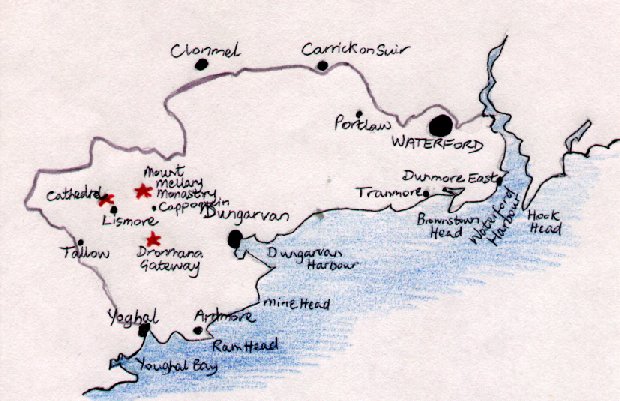|
| Ardmore
This is a popular seaside town built on the site where a monastery was established in the 5th century by St. Declan, who brought Christianity to this area.There are a selection of good shops and pubs, and an excellent beach popular with families. St. Declan's Cathedral The Cathedral dates from the 12th century and boasts some fine Romanesque sculptures, which can be seen despite most of the building being in ruins. there is a superb round tower which is some 30m (95 feet) high. there is an oratory nearby which is thought to mark the grave of St. Declan. Dunmore East Dunmore East is a very pretty fishing village. There is a beach and up behind the Haven Hotel are some gardens which have wonderful views of the harbour. Lismore
Lismore is a peaceful riverside town. It was built on the site of a former
monastery , founded by St. Carthage here in the 7th century. The town
is dominated by Lismore Castle which looks down on the
River Blackwater. It was built in 1185, but remodelled , as many of
them were, in the 19th century. The castle is the seat of the Duke
of Devonshire and is not open to the public, however you can visit the
gardens. Passage East This port some 12 km (7 miles) east of Waterford is where the Normans landed in 1170. It has a car ferry which links it to Ballyhack in county Wexford, giving travellers a pretty shortcut to the county or the Hook Peninsula. Waterford Waterford was founded because of its position on the estuary of the River Suir. It was established by the Vikings in 853 AD, and much is being made to salvage and save these historic beginnings. Later the city was added to by the Anglo-Normans, and it became prosperous thanks to local industries such as the glass for which the city is still famous. Some of the city walls built by the vikings can still be seen, as in the section that runs from the Watch Tower in a north-easterly direction. There are also sallyports, or arches through which boats sailed down the river which can be seen in the Reginald Bar. Much of the layout of the city is medieval but its finest buildings are largely Georgian. Christchurch Cathedral A local architect, John Roberts designed the Cathedral which was built in the 1770's. It is fronted by a fine Corinthian colonnade. John Roberts contributed much to the city's Georgian heritage. Grey Friars This 13th century church, now a ruin, is often referred to as the French church as it became a Huguenot chapel in 1693. Holy Trinity Cathedral This Cathedral contains some lovely Neo-Classical features. Reginald's Tower The tower built by the Normans was erected on the site of an earlier Viking tower built in 1003. The walls are some 3 m (10 feet) thick and are said to be the first walls in Ireland to use mortar. The mortar here though is a mixture of fur, mud, lime and blood! It has in its time been a fortress, a prison, a mint, an arsenal and now contains the Civic Museum. Waterford Crystal Factory
George and william Penrose built their glass factory here in 1783 because
of its port. It became very popular very fast, but sadly heavy taxation
caused the firm to close in 1851. In 1947 a new factory opened bringing
in master blowers and engravers from the continent to train local workers.
It is situated 2.5 km (1.5 miles) south of the city centre. Waterford
crystal is different from other glass in that it has a very high lead
content, some 30% in Waterford crystal's case. Visitors can see the
glass in all stages of production, from blowing to engraving.
The factory's main hallmark, besides the thickness of the glass and
deep cuts into it, is its signature engraved into the base of each piece.
Despite the popularity of crystal from tipperary and Galway, Waterford
remains the most popular mostly due to the North American market. Waterford Heritage Centre Situated in Grey Friars Street, this museum tells the story of the city. It uses models and has many artifacts from viking and medieval times. |
